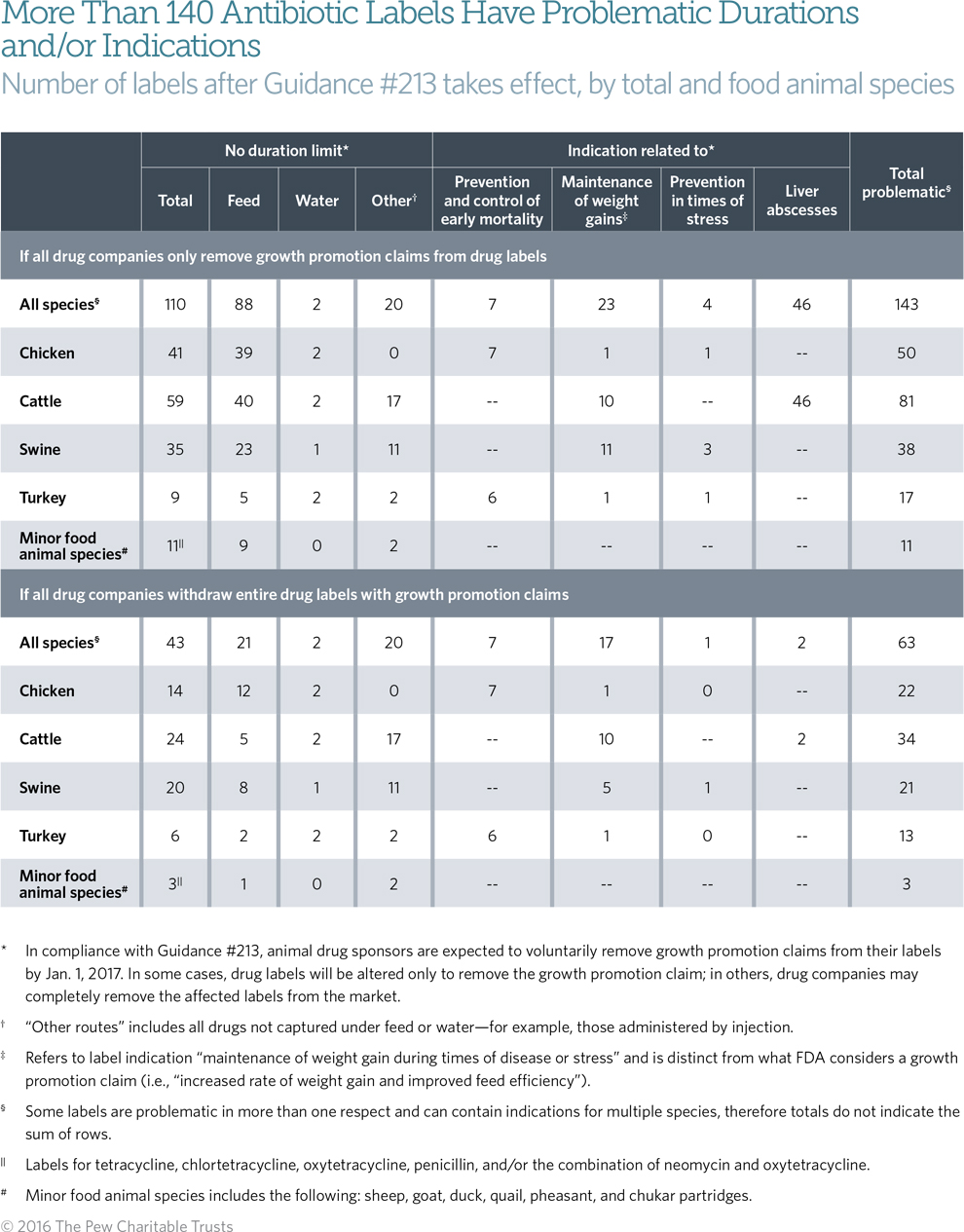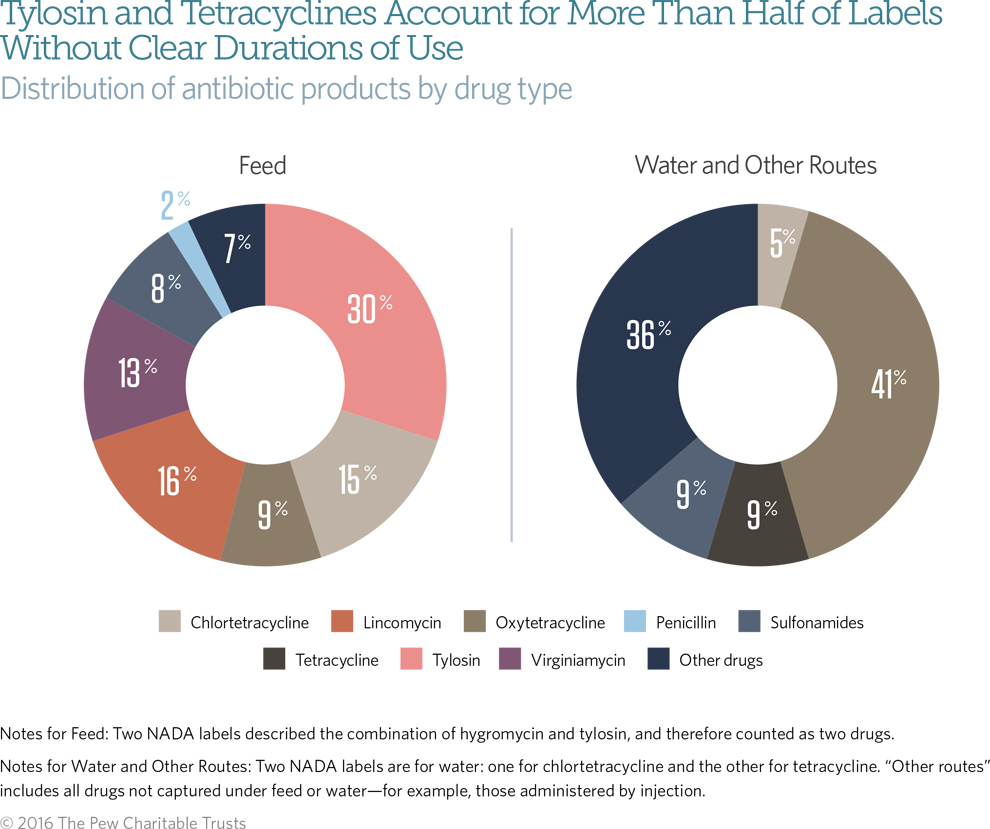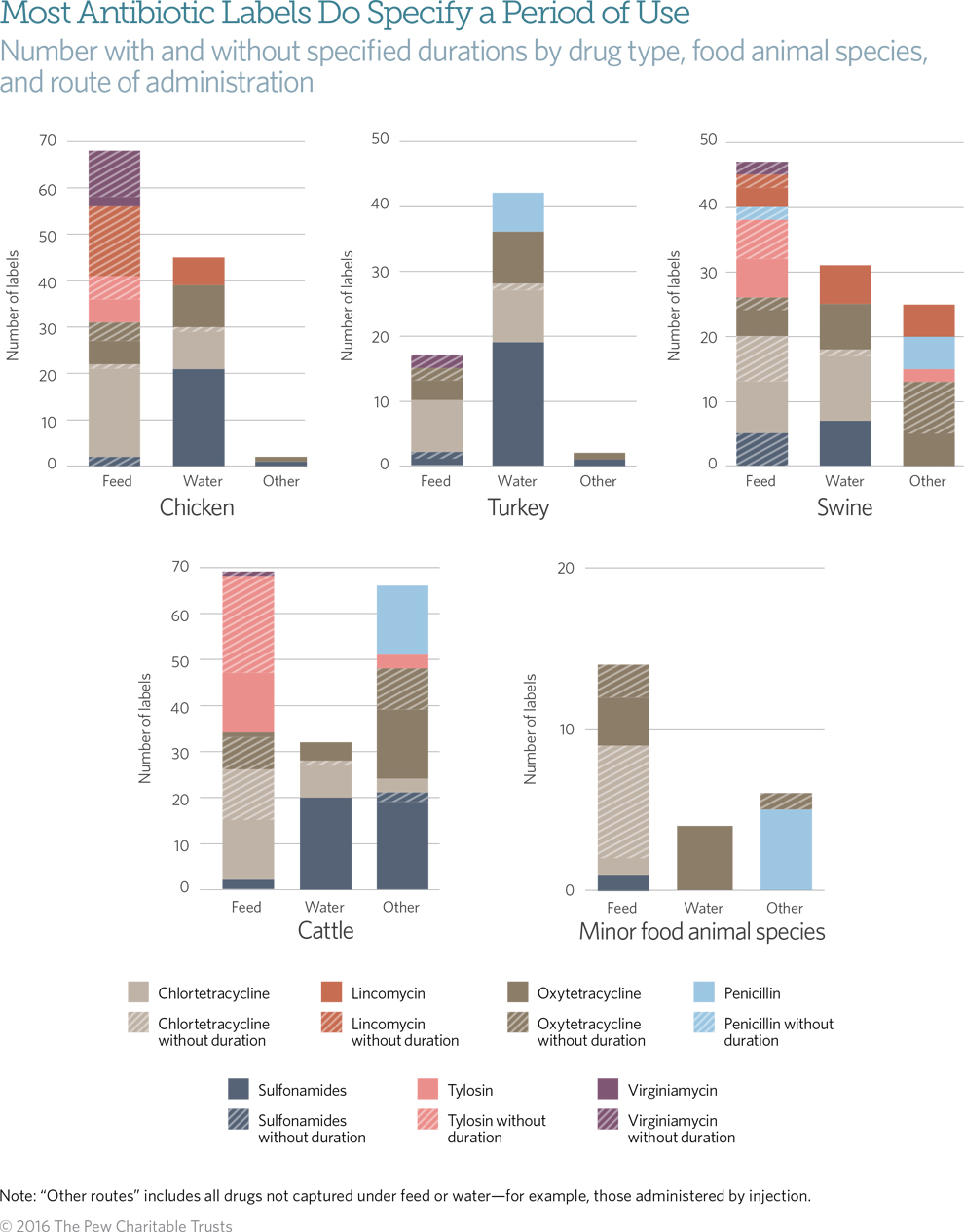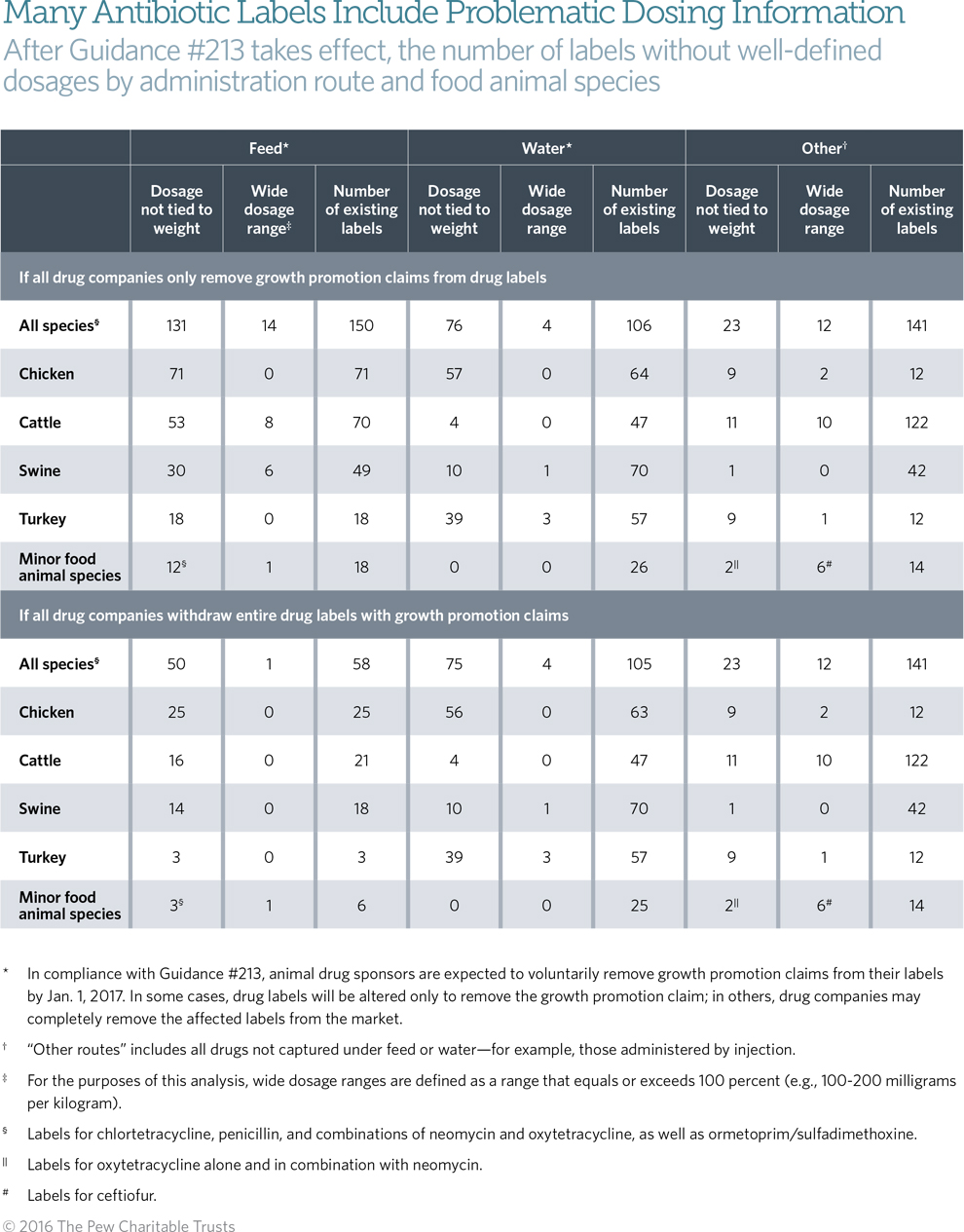Judicious Animal Antibiotic Use Requires Drug Label Refinements
Analysis shows more than 1 in 3 labels will not fully meet judicious use standards after implementation of FDA policy
Overview
The U.S. Food and Drug Administration’s Guidance for Industry #2131—a policy designed to ensure the judicious use of antibiotics that are medically important to humans in the production of food animals—will take effect Jan. 1, 2017. The guidance, which was published in December 2013, asks animal drug companies to make two changes for antibiotics shared by humans and animals: remove indications for promoting growth from the labels of antibiotic products and require veterinarians to oversee the addition of these drugs to feed and water for any reason. Although Guidance #213 is voluntary, animal drug companies already have agreed to comply, and producers and veterinarians will have to follow the revised labels. Once implemented, the policy will change the way medically important antibiotics are used on farms, which is an important step in ensuring the judicious use of these drugs.
Antibiotics are sometimes necessary to prevent or control disease in animals and thereby protect their health. By limiting uses of medically important antibiotics to those necessary for ensuring animal health, and placing them under veterinary oversight, FDA’s judicious use principles aim to help curb the emergence of resistant bacteria.2 The American Veterinary Medical Association defines these principles in greater detail, including limiting treatments to the minimum duration needed for achieving the desired response, choosing evidence-based treatment regimens, and confining treatments to appropriate clinical indications.3 The OIE (World Organisation for Animal Health) has similarly developed guidelines for prudent antibiotic use,4 which are aligned with the judicious use principles described on the previous page.
What are antibiotic drug labels and why are some problematic?
Animal drugs, including antibiotics, have label instructions that define their allowable uses. These instructions are part of the FDA approval process and specify a drug’s indication of use (the health problems to be addressed) and the treatment regimen, including administration route, dosage, dosing frequency, and duration.
To evaluate whether antibiotic labels are consistent with judicious use principles, Pew reviewed the labels of all currently approved, medically important antibiotics for food animals in the United States. As Guidance #213 is implemented, growth promotion will either be removed from the product label, or the product will be withdrawn from the market. Therefore, for the purposes of this analysis, growth promotion claims were excluded. (See methodology.)
The analysis found that even after the policy changes take effect, a number of labels will remain problematic and some injudicious uses may persist. Of the 389 labels for medically important antibiotics,5 about 240 define the conditions for use in a manner consistent with judicious use principles. However, more than 140 labels do not fully meet FDA’s judicious use standards, and around three-quarters of these potentially problematic labels are for pioneer (brand name or patented) drugs. This is an important distinction, because the label of a generic drug has to reflect that of the pioneer drug on which it is based. More than half of the problematic labels do not contain a growth promotion claim and therefore will not be affected by, or potentially removed from market because of, the policy changes mandated by Guidance #213.
This is important because some drug companies may choose to completely withdraw certain affected drugs from the market rather than revise their labels to remove growth promotion claims. Even in the unlikely event that every drug company decides to completely withdraw all labels that include growth promotion claims, almost half of the labels identified in this analysis that continue to promote other problematic uses would remain on the market.
Of the 389 labels, over 100 lack adequate restrictions on the duration of use, several labels do not specify a narrowly defined dosage, and 80 labels raise concerns about whether the specified indication is judicious. (See Tables 1 and 2.) FDA is responsible for ensuring that all labels of marketed, medically important antibiotics reflect current judicious use principles. This includes placing maximum durations on use, clearly specifying indications, and providing appropriate dosing instructions.
Duration of use
Judicious use requires that antibiotics be used only as long as needed to achieve the desired effect. Labels that permit uses of medically important antibiotics for open-ended or undefined durations are inconsistent with this6 and should be revised so that the duration is appropriately limited. In fact, while most labels specify clear duration limits and almost all specify periods of less than three weeks, almost 30 percent of the labels list open-ended or undefined durations of use. Tylosin and tetracyclines (e.g., chlortetracycline, oxytetracycline) are the most common antibiotics with labels lacking a defined duration. (See Figure 1.)
Table 1
Figure 1
Notably, for many of these problematic antibiotic labels with no defined duration, other labels exist for the same or similar indications in the same animal species that do specify a duration of use. Therefore, scientifically based duration limits are available, although product-specific differences have to be considered, for example in administration routes (i.e., via feed, water, or other routes such as injection) or product formulation. In fact, for the most common antibiotics lacking a specified duration (i.e., sulfonamides, chlortetracycline, oxytetracycline, tylosin, lincomycin, virginiamycin, and penicillin), the majority of available labels clearly define durations. (See Figure 2.)
In addition, a few labels specify durations of use far exceeding two or three weeks. For example, some labels for tylosin in feed list an administration of up to six weeks for the treatment and control of swine dysentery. Finally, some problematic labels have duration limits that are tied to poorly defined external factors, such as during “times of stress.”
Figure 2
It is important to note that addressing the problematic labels described here will not lead to undue treatment shortages for minor food-producing species such as sheep and goats. Only 11 of the labels without a defined duration are approved for these species and largely represent drugs such as tetracyclines, for which a number of well-defined labels also exist.
FDA has stated publicly that it “believes long-term or open-ended use of medically important antibiotics is a significant stewardship issue” and has announced plans to seek stakeholder input on this subject.7 The agency committed to gathering feedback as early as in summer 2015 and should now take concrete steps to ensure that the labels of all medically important antibiotics have clearly defined duration limits that are scientifically based and consistent with judicious use practices.
Specific indications
Using antibiotics judiciously requires choosing the right drug for a given health problem,8 which in turn means that indications should be specific enough to guide veterinarians. Although most labels indicate usage for a specific pathogen or disease, others either do not have clear indications or have ones that are problematic:
- Maintenance of weight gain: Twenty-three drug labels include indications for the maintenance of weight gain during disease or times of stress. In these cases, the antibiotic is used to achieve a production outcome rather than to treat or prevent a specific disease.
- Prevention or control of early mortality: Seven drug labels include indications in this category. FDA should ensure that labels reflect the specific disease behind early mortality.
- Disease prevention during times of stress: Four drug labels include indications related to this condition. Antibiotic use necessitated solely by the presence of stress may be avoidable and needs to be reconsidered.
- Questionable disease or condition: In addition to the above examples, some labels specify antibiotic use that may not be medically necessary or appropriate. For example, 46 labels include indications related to reducing the prevalence of liver abscesses in cattle, which is primarily a management-related condition typically caused by grain overload as a result of the feeding regimen. In this case, antibiotic use is not primarily directed at ensuring the health and well-being of the animal but at reducing economic losses caused by liver condemnation at slaughter, which means the liver cannot be sold for human consumption.9
Dosage
Using antibiotics judiciously means choosing the right dosage regimen to ensure efficacy and minimize the risk of resistance. Not all drug labels, however, provide veterinarians with a clearly defined dosage. For example, of the drugs that are not administered via feed or drinking water, almost 25 percent do not specify a narrowly defined dosage directly connected to the animal’s weight. In addition, 14 labels for drugs given in feed, four for drugs given in water, and 12 for drugs administered through other routes have an excessively wide dosage range.10 (See Table 2.) It may not be feasible in all cases to specify a narrow dose tied to the weight of the animal and in some instances veterinarians may have to adjust dosages based on the specifics of a case; however, because selecting the right dosage is central to ensuring efficacy, labels that do not specify dosage based on an animal’s weight or provide for an inordinately wide dosage range should be critically reviewed to ensure they are consistent with FDA criteria for judicious use.
Table 2
FDA needs to act
According to FDA data, the amount of medically important antibiotics sold for food-producing animals increased 23 percent between 2009 and 2014, the most recent year for which data are available.11 It is therefore more important than ever that these lifesaving drugs be used judiciously.
Moreover, because potentially problematic labels will remain after full implementation of Guidance #213, it is crucial to take additional steps to address them now. This analysis shows that the problem is manageable and identifies the biggest issue areas, which can help FDA decide how to prioritize resources for the review and revision of antibiotic labels. For example, because use of feed drugs in ways that deviate from label instructions is illegal,12 review of these labels may be a particular priority for FDA. As noted previously, addressing the problematic labels described here will not lead to undue treatment shortages for minor food-producing species, such as sheep and goats. Only a few of the problematic labels are approved for these species, and in most of these cases other treatment options exist. This is vital because treatment options are limited in minor species, and inhibiting them further could jeopardize animal welfare.
FDA has publicly committed to ensuring that labels follow the judicious use of antibiotics in food animals, in particular with respect to establishing appropriate durations of use. The agency should go further and announce a concrete plan and timeline for making all label revision changes—regarding duration limits and other aspects of appropriate use—as quickly as possible and follow through accordingly.
Methodology
Data source. FDA provided Pew a data set in March 2016, consisting of drug label information for all medically important animal antibiotics approved for use in food-producing species in the U.S., including currently marketed drugs and those not being marketed. The data were sourced from the database informing the Animal Drugs @ FDA website. Additionally, the analysis incorporated supplemental data, also sourced from FDA’s animal drug database, in August 2016. Notably, there can be a delay between when changes, including withdrawals, are made to labels and when they are reflected in relevant databases. Therefore, data searches in other databases (e.g., Food Animal Drug Residue Avoidance & Databank) may yield slightly different results.
Data coding. Coding was complicated by the fact that the same product may be approved for a variety of indications in several species. To standardize counting, each unique combination of New Animal Drug Application (NADA) number for pioneer drugs, or Abbreviated New Animal Drug Application (ANADA) number for generics, and species was counted as a label. Each label was coded for dosage, duration, and indication using a set of categorical variables. If a label consisted of multiple indications (potentially with separate dosages and durations for each one), coding was based on the least-defined value excluding growth promotion indications (labels containing growth promotion uses were counted separately, and all of these claims were excluded from the analysis). The values were not necessarily linked by indication, meaning that values coded for dosage and duration may be associated with different indications on the same label.
Growth promotion labels. In compliance with Guidance #213, animal drug sponsors are expected to voluntarily remove growth promotion claims from their labels by Jan. 1, 2017. No growth promotion claims were included in this analysis. In some cases, drug companies may completely remove the affected labels from the market; in others, drug labels will be altered only to remove the growth promotion claim. To evaluate the likely label landscape after Jan. 1, drug labels that include growth promotion claims were identified separately from those that do not; this permits a separate analysis for theoretical situations in which every affected drug company completely removes affected labels from the market and companies remove only growth promotion claims and otherwise keep all of the labels unaltered.
Dosage. Dosages were categorized by whether they were tied to animal weight. Labels were grouped by whether weight was presented as a single value or a range. Labels indicating that a single dose be given to newborn animals were considered tied to the weight of the animal. Labels with a narrow dosage range were defined as those with less than 100 percent variance and tied to the weight of the animal. Labels with wide dosage ranges were defined as those with greater than 100 percent variance and were tied to the weight of the animal.
Combination products. Products that contained two or more active ingredients were coded based on the medical importance of the antibiotics: If the product had two medically important antibiotics, the label was coded accordingly; if the product contained one medically important antibiotic and one or more other active ingredients (e.g., non-medically important antibiotics; nonsteroidal anti-inflammatory drugs), the label was coded based on the medically important antibiotic only.
Data analysis. Numbers of labels for the various categories displayed in the summary tables were counted manually. Separate counts were included for cattle, chicken, turkey, swine, and minor food animal species, such as sheep and goats. If labels had the same NADA/ANADA number but were associated with different species, each label was counted separately. Duplicate labels (multiple entries with the same NADA/ANADA number and species) were removed.
Specific label considerations:
- Feed drugs are those labeled “Medicated feed” or “Type A medicated feed.”
- Water drugs are a subset of those with “Liquid,” “Liquid (solution),” “Powder,” and “Soluble powder” dosage forms with “Oral,” “Oral via drinking water,” and “Per os” administration routes. For drugs in these categories, label instructions were reviewed for the specification of the administration in water, and only those products with clear instructions for use in drinking water were counted as water drugs.
- Other routes of administration. This category included all labels not captured under feed or water drugs. Notably, labels that specified use for drenching and/or use in drinking water were counted as water drugs, and labels that specified use only for drenching were captured under the “other routes” category.
- Labels with no instructions. Several labels were found to have no usage information on label indications. After cross-checking with Animal Drugs @ FDA, these labels have information only on tolerances and no instruction on how to use the drug.
- Withdrawn drugs. Drugs voluntarily withdrawn by sponsors were identified using FDA’s Section 6.0— Voluntary Withdrawal list (January 2016) from the Approved Animal Drug Products (Green Book).13
- Quality control. Pew staff duplicated all steps of data coding and analysis to ensure quality control. After the data were coded, values were compared and discrepancies resolved. Then, all data were independently crosschecked by a third Pew staff person. The data set was cross-checked with Animal Drugs @ FDA.
External Reviewers
The issue brief benefited from the insights and expertise of external peer reviewers Jim Riviere, D.V.M., Ph.D., the MacDonald Chair in Veterinary Medicine, Distinguished Professor, Kansas State University, and Mark Papich, D.V.M, M.S., Dipl. ACVCP, Burroughs Wellcome Fund Professor, Veterinary Pharmacology, North Carolina State University. Neither the peer reviewers nor their organizations necessarily endorse the conclusions provided in this report.
Acknowledgments
The findings and conclusions in this issue brief are those of the authors only. The authors are grateful to the Food and Drug Administration’s Center for Veterinary Medicine for its technical assistance and feedback on this analysis. We would also like to thank the following Pew colleagues for their valuable contributions to this report: Kyle Kinner for his strategic advice; Timothy Cordova for his thorough efforts on data-checking; and Demetra Aposporos, Laurie Boeder, Heather Cable, Erika Compart, Jennifer V. Doctors, Bailey Gregory, Aesah Lew, Bernard Ohanian, Katherine Portnoy, and Liz Visser for their editorial input and production assistance.
Endnotes
- Food and Drug Administration, “Guidance for Industry #213: New Animal Drugs and New Animal Drug Combination Products Administered in or on Medicated Feed or Drinking Water of Food-Producing Animals—Recommendations for Drug Sponsors for Voluntarily Aligning Product Use Conditions With GFI #209,” FDA Center for Veterinary Medicine (December 2013), http://www.fda.gov/downloads/AnimalVeterinary/ GuidanceComplianceEnforcement/GuidanceforIndustry/UCM299624.pdf.
- Food and Drug Administration, “FDA Guidance for Industry #209: The Judicious Use of Medically Important Antimicrobial Drugs in Food-Producing Animals,” FDA Center for Veterinary Medicine (April 13, 2012), http://www.fda.gov/downloads/AnimalVeterinary/ GuidanceComplianceEnforcement/GuidanceforIndustry/UCM216936.pdf.
- American Veterinary Medical Association, “Judicious Therapeutic Use of Antimicrobials,” accessed Aug. 1, 2016, https://www.avma.org/KB/Policies/Pages/Judicious-Therapeutic-Use-of-Antimicrobials.aspx. The AVMA has its own set of judicious use principles, including: “Therapeutic exposure to antimicrobials should be minimized by treating only for as long as needed for the desired clinical response”; “Regimens for antimicrobial treatment, control, or prevention of disease should be based upon current scientific and clinical principles, such as microbiological and pharmacological tenets”; and “Antimicrobial use should be confined to appropriate clinical indications. Inappropriate uses such as for uncomplicated viral infections should be avoided.”
- OIE (World Organisation for Animal Health), OIE International Standards on Antimicrobial Resistance (2003), http://www.oie.int/doc/ged/D12196.PDF.
- For the purposes of this analysis, a “label” is a unique combination of NADA/ANADA number and species; labels not currently approved are excluded while pioneer and generic drugs are considered separately. See methodology.
- Food and Drug Administration, “FDA Fact Sheet: Veterinary Feed Directive Final Rule and Next Steps,” last modified Dec. 17, 2015, http://www.fda.gov/AnimalVeterinary/DevelopmentApprovalProcess/ ucm449019.htm.
- Ibid and Docket No. FDA-2016-D-2635, 81 FR 63187, https://www.federalregister.gov/documents/2016/09/14/2016-21972/thejudicious-use-of-medically-important-antimicrobial-drugs-in-food-producing-animals-establishing.
- Food and Drug Administration, “FDA Fact Sheet: Veterinary Feed Directive Final Rule and Next Steps,” last modified Dec. 17, 2015, http://www.fda.gov/AnimalVeterinary/DevelopmentApprovalProcess/ ucm449019.htm.
- T.G. Nagaraja and Kelly F. Lechtenberg, “Liver Abscesses in Feedlot Cattle,” Veterinary Clinics of North America: Food Animal Practice 23, no. 2 (2007): 351–69, http://www.ncbi.nlm.nih.gov/pubmed/17606156; and T.G. Nagaraja and M.M. Chengappa, “Liver Abscesses in Feedlot Cattle: A Review,” Journal of Animal Science 76, no. 1 (1998): 287–98, http://www.ncbi.nlm.nih.gov/pubmed/9464910.
- For the purposes of this analysis, wide dosage ranges are defined as a variation that equals or exceeds 100 percent (e.g., 100-200 milligrams per kilogram).
- Food and Drug Administration, 2014 Summary Report on Antimicrobials Sold or Distributed for Use in Food-Producing Animals (December 2015), http://www.fda.gov/downloads/ForIndustry/UserFees/ AnimalDrugUserFeeActADUFA/UCM476258.pdf.
- Food and Drug Administration, “Animal Medicinal Drug Use Clarification Act of 1994 (AMDUCA),” last modified Dec. 9, 2014, http://www.fda.gov/AnimalVeterinary/GuidanceComplianceEnforcement/ ActsRulesRegulations/ucm085377.htm. In the United States, veterinarians may prescribe animal drugs for use in ways other than those described on the label under certain circumstances (e.g., different dosage or duration of use); however, feed drugs are excluded from those exemptions.
- Food and Drug Administration, Section 6.0 Voluntary Withdrawal (January 2016), http://www.fda.gov/downloads/AnimalVeterinary/Products/ ApprovedAnimalDrugProducts/UCM042864.pdf.













